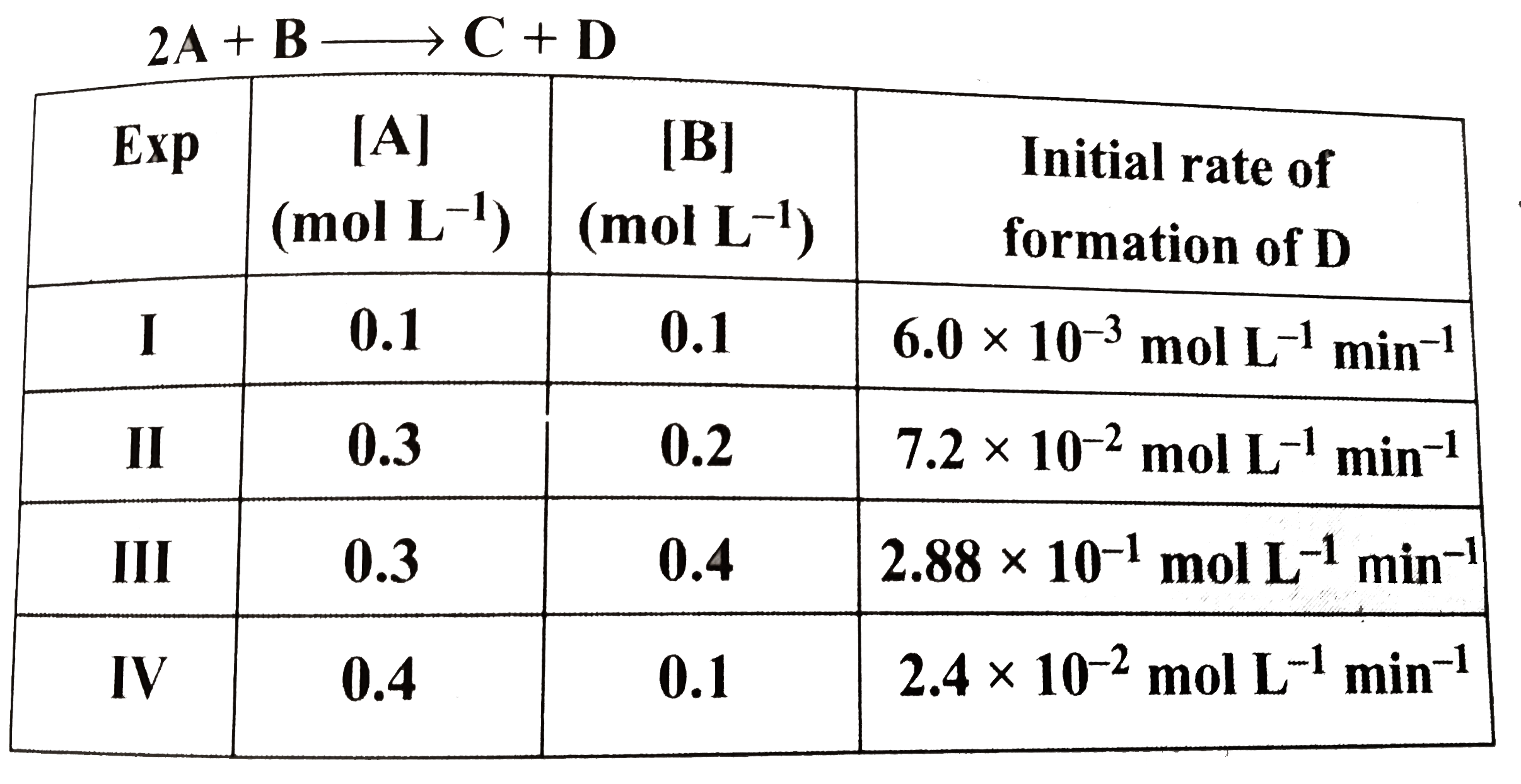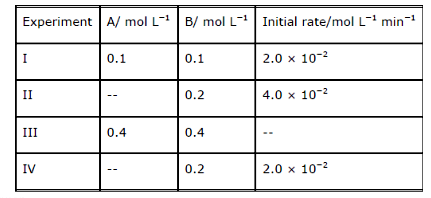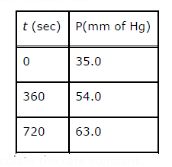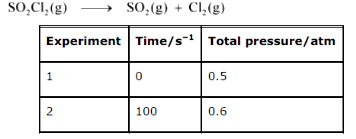Complete Solutions to Solved Examples of chapter CHEMICAL KINETICS of Class 12 book with complete answers and questions
| Class 12 | CHEMISTRY |
| Chapter | CHEMICAL KINETICS |
| NCERT | Solved Examples |
| Number Of Questions | 47 |
| Academic Year | 2023-24 |
From the concetration of `C_(4)H_(9)Cl` (butyl chloride) at different times given below, calculate the average rate of reaction:
`C_(4)H_(9)Cl+H_(2)O rarr C_(4)H_(9)OH+HCl`
during different intervals of time.
`|{:([C_(4)H_(9)Cl] (mol L^(-1)),t (s)),(0.100,0),(0.0905,50),(0.0820,100),(0.0741,150),(0.0671,200),(0.0549,300),(0.0439,400),(0.0210,700),(0.017,800):}|`
View SolutionThe decompoistion of `N_(2)O_(5)` in `C CI_(4)` solution at `318 K` has been studied by monitoring the concentration of `N_(2)O_(5)` in the solution. Initially, the concentration of `N_(2)O` is `2.33 M` and after `184 min`, it is reduced to `2.08 M`. The reaction takes place according to the equation:
`2N_(2)O_(5) rarr 4NO_(2) + O_(2)`
Calculate the average rate of this reaction in terms of hours, minutes, and seconds. What is the rate of Production of `NO_(2)` during this period?
View SolutionCalculate the overall order of a reaction which has the rate expresison.
(a) Rate`= k[A]^((1)/(2))[B]^((3)/(2))` , (b) Rate `= k[A]^((3)/(2))[B]^(-1)`
View SolutionIdentify the reaction order from each of the following rate constants.
(i) k `= 2.3xx10^(-5)Lmol^(-1)s^(-1)`
(ii) k `= 3xx 10^(-4)s^(-1)`
View SolutionThe initial concentration of `N_(2)O_(5)` in the following first order reaction:
`N_(2)O_(5)(g) rarr 2NO_(2)(g)+(1)/(2)O_(2)(g)`
was `1.24 xx 10^(-2) mol L^(-1)` at `318 K`. The concentration of `N_(2)O_(5)` after `60 min` was `0.20 xx 10^(-2) mol L^(-1)`. Calculate the rate constant of the reaction at `318 K`.
View SolutionThe following data were obtained during the first thermal decompoistion of `N_(2)O_(5) (g)` at constant volume.
`2N_(2)O_(5) (g) rarr 2N_(2)O_(4) (g)+O_(2)(g)`
`|{:("S.No.","Time (s)","Total pressure (atm)"),(i.,0,0.5),(ii.,100,0.512):}|`
Calculate the rate constant.
View SolutionA first order reaction is found to have a rate constant `k= 5.5 xx 10^(-14)s^(-1)`. Find half-life of the reaction.
View SolutionWhen reaction is completed 99.9%,`[R]_(n) = [R]_(0) - 0.999[R]_(0)`
View SolutionThe rate constant of a reaction at `500 K` and `700 K` are `0.02s^(-1)`, respectively. Calculate the values of `E_(a)` and `A` at `500 K`.
View SolutionThe first order rate constant for the decomposition of `C_(2)H_(5)I` by the reaction.
`C_(2)H_(5)I(g)rarrC_(2)H_(4)(g)+HI(g)`
at `600 K is 1.60xx10^(-5)s^(-1)`. Its energy of activation is `209 kJ mol^(-1)`. Calculate the rate constant at `700 K`
View SolutionIn a reaction, `2Ararr` Products the concentration of A decreases from `0.5` mol `litre^(-1)` to `0.4` mol `litre^(-1)` in `10` minutes. Calculate rate during this interval.
View SolutionFor a reaction, `A+Brarr` Product, the rate law is given by `r=k[A]^((1)/(2))[B]^(2)`. What is the order of the reaction ?
View SolutionThe conversion of molecules `X` to `Y` follows second order kinetics. If the concenration of `X` is increased to three times, how will it affect the rate of formation of `Y` ?
View SolutionA first order reaction has a rate constant `1.15xx10^(-3)s^(-1)`. How long will `5g` of this reactant take to reduce to `3g`` ?
View SolutionTime required to decompose `SO_(2)Cl_(2)` to half of its intial amount is `60 mi n.` If the decomposition is a first order reaction, calculate the rate constant of the reaction.
View SolutionWhat will be effect of temperature on rate constant ?
View SolutionThe rate of the chemical reaction doubles for an increase of 10 K in absolute temperature from 298 K. Calculate Ea.
View SolutionThe activation energy for the reaction `:`
. `2Hl(g) rarr H_(2)(g)+I_(2)(g)`
is `209.5 kJ mol^(-1)` at `581K`. Calculate the fraction of molecules of reactants having energy equal to or greater than activation energy ?
View SolutionFrom the rate expression for the following reactions, determine their order of reaction and dimensions of the rate constants.
`a. 3NO(g) rarr N_(2)O(g),` Rate`=k[NO]^(2)`
`b. H_(2)O_(2)(aq)+3I^(-)(aq)+2H^(o+) rarr 2H_(2)O(l)+I_(3)^(-),` Rate`=k[H_(2)O_(2)][I^(-)]`
`c. CH_(3)CHO(g)rarr CH_(4)(g)+CO(g),` Rate`=k[CH_(3)CHO]^(3//2)`
`d. C_(2)H_(5)Cl(g) rarr C_(2)H_(4)(g)+HCl(g),` Rate `k[C_(2)H_(5)Cl]`
View SolutionFor the reaction `:`
`2A+B rarr A_(2)B`
the rate `=k[A][B]^(2)` with `k=2.0xx10^(-6)mol^(-2)L^(2)s^(-1)`. Calculate the initial rate of the reaction when `[A]=0.1 mol L^(-),[B]=0.2 mol L^(-1)`. Calculate the rate of reaction after `[A]` is reduced to `0.06 mol L^(-1)`.
View SolutionThe rate for the decomposition of `NH_(3)` on platinum surface is zero order. What are the rate of production of `N_(2)` and `H_(2)` if `K = 2.5 xx 10^(-4) "mol litre"^(-1)s^(-1)`?
View SolutionThe decomposition of dimethyl ether leads to the formation of `CH_(4),H_(2),` and `CO` and the reaction rate is given by
Rate `=k[CH_(3)OCH_(3)]^(3//2)`
The rate of reaction is followed by increase in the pressure in a closed vessel , so the rate can also be expressed in terms of the partial pressure of dimethyl either, `i.e., `
Rate `=k[p_(CH_(3)OCH_(3))]^(3//2)`
If the pressure is measured in bar and time in minutes, then what are the units of rate and rate constant ?
View SolutionMention the factors that affect the rate of a chemical reaction.
View SolutionA reaction is second order with respect to a reaction. How is the rate of reaction affected if the
(a) doubled, (b) reduced to `1//2`?
View SolutionWhat is the effect of temperature on the rate constant of a reaction ? How can this temperature effect on rate constant be represented quantitatively ?
View SolutionIn a pseudo first order hydrolysis of ester in water the following results were obtained:
`{:(t//s,0,30,60,90),(["Ester"],0.55,0.31,0.17,0.085):}`
(i) Calculate the average rate of reaction between the time interval `30` to `60` seconds.
(ii) Calculate the pseudo first order rate constant for the hydrolysis of ester.
View SolutionA reaction is first order in `A` secod order in `B`:
(i) write differential rate equation.
(ii) How is the rate affected when the concentration of `B` is tripled ?
(iii) How is the rate affected when the concentration of both `A` and `B` is doubled?
View SolutionIn a reaction between A and B, the initial rate of reaction was measured for different initial concentrations of A and B as given below:

What is the order of reaction with respect to A and B ?
View SolutionThe following rate data were obtained at `303 K` for the following reaction:
`2A + B rarr C + D`

What is the rate law? What is the order with respect to each reactant and the overall order? Also calculate the rate constant and write its units.
View SolutionThe reaction between A and B is first order with respect to A and zero order with respect to B. Fill in the blanks in the following table:

View SolutionCalculate the half life of a first order reaction from their rate constants given below `:`
`a. 200s^(-1)`,`b. 2 mi n^(-1)`,`c.4years^(-1)`
View SolutionThe half life for radioactive decay of `.^(14)C` is 5730 years. An archaeological artifact containing wood had only `80%` of the `.^(14)C` found in a living tree. Estimate the age of the sample.
View SolutionThe rate constant for the first order reaction is `60 s^(-1)`. How much time will it take to reduce the concentration of the reactant to `1//16th` value ?
View SolutionDuring nuclear explosion, one of the products is `.^(99)Sr` with half`-` life of `28.1 `years. If `1 mug` of `.^(90)Sr` was absorbed in the bones of a newly born baby instead of calcium, how much of its will remain after 10 years and 60 years if it is not lost metabolically.
View SolutionFor a first order reaction, show that the time required for `99%` completion is twice the time required for the completion of `90%` of reaction.
View SolutionA first order reaction takes `40 mi n ` for `30%` decomposition. Calculate `t_(1//2)`.
View SolutionFor the decomposition of azoisopropane to hexane and nitrogen at 54
K, the following data are obtained.

Calculate the rare constant.
View SolutionThe following data were obtained during the first order thermal
decomposition of `SO_(2)Cl_(2)` at a constant volume `SO_(2)Cl_(2)(g)to SO_(2)(g)+Cl_(2)(g)`

Calculate the rate of the reaction when total pressure is 0.65 atm
View SolutionThe rate constant for the decomposition of `N_(2)O_(5)` at various temperatures
is given below:

Draw a graph between ln k and 1/T and calculate the values of A and
`E_(a)`. Predict the rate constant at `30^(@)` and `50^(@)C`.
View SolutionThe rate constant for the decomposition of hydrocarbons is `2.418xx10^(-5)s^(-1)` at `546K`. If the energy of activation is `179.9kJ mol^(-1)`, what will be the value of pre`-`exponential factor?
View SolutionConsider a certain reaction `A rarr` Products with `k=2.0xx10^(-2)s^(-1)`. Calculate the concentration of `A` remaining after `100s` if the initial concentration of `A` is `1.0 mol L^(-1)`.
View SolutionSucrose decomposes in acid solution into glucose and fructose according to the first order rate law, with `t_(1//2)=3.00hr.` What fraction of sample of sucrose remains after `8 hr` ?
View SolutionThe decomposition of hydrocarbon follows the equation `k=(4.5xx10^(11)s^(-1))e^(-28000K//T)`
Calculate `E_(a)`.
View SolutionThe rate constant for the first order decomposition of a certain reaction is described by the equation
`log k (s^(-1)) = 14.34 - (1.25 xx 10^(4)K)/(T)`
(a) What is the energy of activation for the reaction?
(b) At what temperature will its half-life period be `256 min`?
View SolutionThe decomposition of `A` into product has value of `k` as `4.5xx10^(3)s^(-1)` at `10^(@)C` and energy of activation of `60kJmol^(-1)`. At what temperature would `k` be `1.5xx10^(4)s^(-1)?`
View SolutionThe time required for `10%` completion of a first order reaction at `298K` is equal to that required for its `25%` completion at `308K` . If the value of `A` is `4xx10^(10)s^(-1)`, calculate `k` at `318K` and `E_(a)`.
View SolutionThe rate of a reaction quadruples when the temperature changes from `293K` to `313K`. Calculate the energy of activation of the reaction assuming that it does not change with temperature.
View Solution
Solved Examples questions and complete solutions for chapter CHEMICAL KINETICS of NCERT CHEMISTRY(ENGLISH) of Class 12